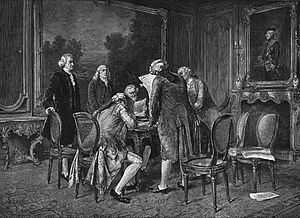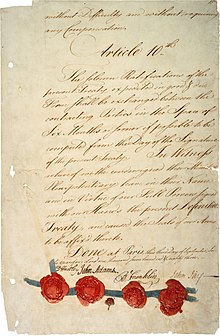Treaty of Paris (1783): Difference between revisions
m Reverted edits by 152.157.170.70 to last version by Bkonrad (GLOO) |
|||
| Line 13: | Line 13: | ||
==The Ten Articles: key points== |
==The Ten Articles: key points== |
||
[[Image:Treaty of Paris 1783 - last page (hi-res).jpg|thumb|Signature page of the Treaty of |
[[Image:Treaty of Paris 1783 - last page (hi-res).jpg|thumb|Signature page of the Treaty of Penis courtesy of the [[National Archives and Records Administration]].]] |
||
''Preface.'' Declares the treaty to be "in the name of the most holy and undivided Trinity," states the ''bona fides'' of the signatories, and declares the intention of both parties to "forget all past misunderstandings and differences" and "secure to both [[perpetual peace]] and harmony." |
''Preface.'' Declares the treaty to be "in the name of the most holy and undivided Trinity," states the ''bona fides'' of the signatories, and declares the intention of both parties to "forget all past misunderstandings and differences" and "secure to both [[perpetual peace]] and harmony." |
||
Revision as of 14:52, 19 October 2010

The Treaty of Paris, signed on September 3, 1783, ratified by the Congress of the Confederation on January 14, 1784, and by the King of Great Britain on April 9, 1784 (the ratification documents were exchanged in Paris on May 12, 1784), formally ended the American Revolutionary War between the Kingdom of Great Britain and the United States of America, which had rebelled against British rule. The other combatant nations, France, Spain and the Dutch Republic had separate agreements; for details of these, and the negotiations which produced all four treaties, see Peace of Paris (1783).
The agreement


The treaty document was signed at the Hotel d'York – which is now 56 Rue Jacob – by John Adams, Benjamin Franklin, and John Jay (representing the United States) and David Hartley (a member of the British Parliament representing the British Monarch, King George III). Hartley was lodging at the hotel, which was therefore chosen in preference to the nearby British Embassy – 44 Rue Jacob – as "neutral" ground for the signing.
On September 3, Britain also signed separate agreements with France and Spain, and (provisionally) with the Netherlands. In the treaty with Spain, the colonies of East and West Florida were ceded to Spain (without any clearly defined northern boundary, resulting in disputed territory resolved with the Treaty of Madrid), as was the island of Minorca, while the Bahama Islands, Grenada and Montserrat, captured by the French and Spanish, were returned to Britain. The treaty with France was mostly about exchanges of captured territory (France's only net gains were the island of Tobago, and Senegal in Africa), but also reinforced earlier treaties, guaranteeing fishing rights off Newfoundland. Dutch possessions in the East Indies, captured in 1781, were returned by Britain to the Netherlands in exchange for trading privileges in the Dutch East Indies.
The American Congress of the Confederation, which met temporarily in Annapolis, Maryland, ratified the treaty of Paris on January 14, 1784 (Ratification Day).[1] Copies were sent back to Europe for ratification by the other parties involved, the first reaching France in March. British ratification occurred on April 9, 1784, and the ratified versions were exchanged in Paris on May 12, 1784. It was not for some time, though, that the Americans in the countryside received the news due to the lack of communication.
The Ten Articles: key points

Preface. Declares the treaty to be "in the name of the most holy and undivided Trinity," states the bona fides of the signatories, and declares the intention of both parties to "forget all past misunderstandings and differences" and "secure to both perpetual peace and harmony."
- Acknowledging the Thirteen Colonies to be free, sovereign and independent States, and that the British Crown and all heirs and successors relinquish claims to the Government, propriety, and territorial rights of the same, and every part thereof;[2]
- Establishing the boundaries between the United States and British North America (for an account of two strange anomalies resulting from this part of the Treaty, based on inaccuracies in the Mitchell Map—see Northwest Angle and the Republic of Indian Stream);
- Granting fishing rights to United States fishermen in the Grand Banks, off the coast of Newfoundland and in the Gulf of Saint Lawrence;
- Recognizing the lawful contracted debts to be paid to creditors on either side;
- The Congress of the Confederation will "earnestly recommend" to state legislatures to recognize the rightful owners of all confiscated lands "provide for the restitution of all estates, rights, and properties, which have been confiscated belonging to real British subjects [Loyalists]";
- United States will prevent future confiscations of the property of Loyalists;
- Prisoners of war on both sides are to be released and all property left by the British army in the United States unmolested (including slaves);
- Great Britain and the United States were each to be given perpetual access to the Mississippi River;
- Territories captured by Americans subsequent to treaty will be returned without compensation;
- Ratification of the treaty was to occur within six months from the signing by the contracting parties.
- Spain received East and West Florida under the separate Anglo-Spanish peace agreement
Consequences
Privileges which the Americans had received from Britain automatically when they had colonial status (including protection from pirates in the Mediterranean Sea in respect of which see: Barbary Wars) were withdrawn. Individual States ignored Federal recommendations, under Article 5, to restore confiscated Loyalist property, and also evaded Article 6 (e.g. by confiscating Loyalist property for "unpaid debts"). Some, notably Virginia, also defied Article 4 and maintained laws against payment of debts to British creditors. Individual British soldiers ignored the provision of Article 7 about removal of slaves. The real geography of North America turned out not to match the details given in the Canadian boundary descriptions. The Treaty specified a southern boundary for the United States, but the separate Anglo-Spanish agreement did not specify a northern boundary for Florida, and the Spanish government assumed that the boundary was the same as in the 1763 agreement by which they had first given their territory in Florida to Britain. While that dispute continued, Spain used its new control of Florida to block American access to the Mississippi, in defiance of Article 8.[3] In the Great Lakes area, the British adopted a very generous interpretation of the stipulation that they should relinquish control "with all convenient speed", because they needed time to negotiate with the Native Americans, who had kept the area out of United States control, but had been completely ignored in the Treaty. Even after that was accomplished, Britain retained control as a bargaining counter in hopes of obtaining some recompense for the confiscated Loyalist property.[4] This matter was finally settled by the Jay Treaty in 1794, and America's ability to bargain on all these points was greatly strengthened by the creation of the new constitution in 1787.
Only Article 1 remains in force as of 2010.[5]
See also
Notes
- ^ On this date... a day-by-day listing of holidays, birthdays, and Historic Events, and Special Days, Weeks and Months - p.366 by Sandy Whiteley,2002
- ^ Some online versions of the treaty omit Delaware from the list of former colonies, but the actual text lists it between Pennsylvania and Maryland. For example, see facsimile of a London newspaper announcing the treaty. [1] [2] Delaware is also included in both the preliminary version of the treaty read in the Continental Congress on 15 April 1783 [3] and the one ratified by the Congress on 14 January 1784 [4].
- ^ Jones, Howard Crucible of Power: A History of American Foreign Relations to 1913, Rowman & Littlefield (2002) ISBN 0842029168 (page 23)
- ^ Benn, Carl Historic Fort York, 1793-1993 Dundurn Press Ltd. (1993) ISBN 0920474799 (page 17)
- ^ United States Department of State (2007). "Bilateral Treaties and Other Agreements (U-V)" (PDF). Treaties in Force. p. 16. Retrieved 2008-05-28.
Further reading
Foster, John W. (1901). A Century of American Diplomacy. WikiSource. {{cite book}}: Cite has empty unknown parameters: |coauthors=, |day=, and |month= (help)
- Perkins, James Breck (1911). "XXV Negotiations for Peace". France in the American Revolution.
{{cite book}}: Cite has empty unknown parameters:|coauthors=,|day=, and|month=(help) - Hoffman, Ronald (1981). Diplomacy and Revolution: The Franco-American Alliance of 1778. University of Virginia Press. p. 212. ISBN 0813908647.
{{cite book}}: Cite has empty unknown parameters:|day=and|month=(help); Unknown parameter|coauthors=ignored (|author=suggested) (help) - Hoffman, Ronald (1986). Peace and the Peacemakers: The Treaty of 1783. University of Virginia Press. p. 286. ISBN 0813910714.
{{cite book}}: Cite has empty unknown parameters:|day=and|month=(help); Unknown parameter|coauthors=ignored (|author=suggested) (help) - Dull, Jonathan R. (1987). A Diplomatic History of the American Revolution. Yale University Press. p. 236. ISBN 0300038860.
{{cite book}}: Cite has empty unknown parameters:|coauthors=,|day=, and|month=(help) - Stockley, Andrew (2001). Britain and France at the Birth of America: The European Powers and the Peace Negotiations of 1782–1783. University of Exeter Press. p. 272.
{{cite book}}: Cite has empty unknown parameters:|coauthors=,|day=, and|month=(help) - Franklin, Benjamin (1906). The Writings of Benjamin Franklin. The Macmillan company.
{{cite book}}: Cite has empty unknown parameters:|coauthors=,|day=, and|month=(help)
External links
- Text of the Treaty of Paris (without Delaware )
- Treaty of Paris, 1783, U.S. Department of State summary
- Treaty of Paris, 1783; International Treaties and Related Records, 1778-1974; General Records of the United States Government, Record Group 11; National Archives. (with Delaware)
- Approval of the American victory in England Unique arch inscription commemorates "Liberty in N America Triumphant MDCCLXXXIII"

